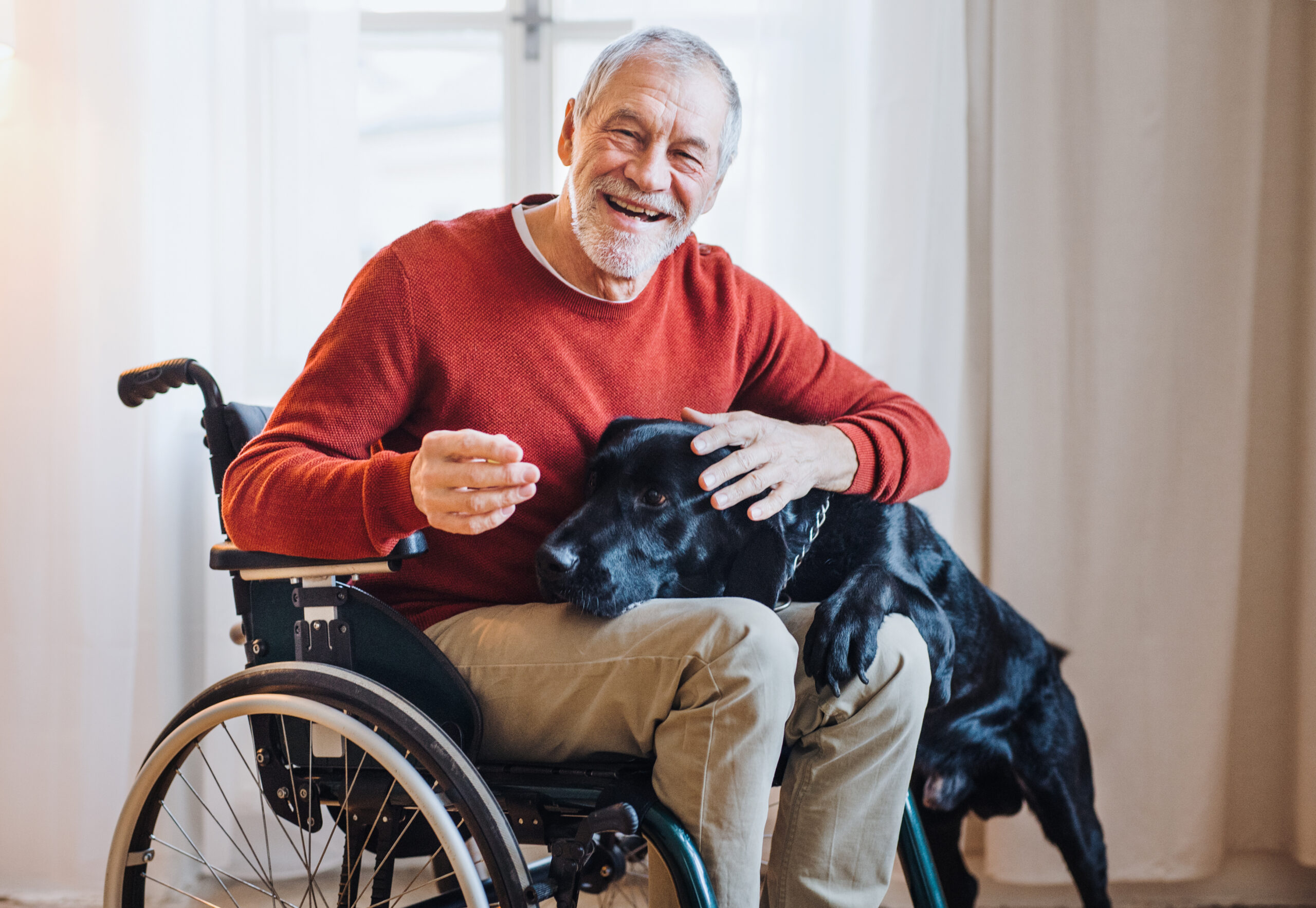Does Pet Therapy Make Life Better?
Imagine the smile on a senior’s face as they interact with a playful dog or the serenity that envelops them while stroking a soft, purring cat. Pet therapy for seniors is more than just a feel-good moment—it’s a profound way to improve their emotional, physical, and cognitive health. For caregivers, embracing pet therapy can be a helpful tool in senior care, offering a unique blend of companionship, stress relief, and health benefits. Our comprehensive guide explores the myriad benefits of implementing pet therapy along with some basic steps to get started. Let’s explore how pet therapy can help create richer, more fulfilling lives for the seniors you care for.
Benefits of Pet Therapy for Seniors
Pet therapy for seniors offers a multitude of benefits that significantly enhance their quality of life. From emotional support and companionship to physical health improvements and cognitive stimulation, the positive impacts of pet therapy are well-documented and transformative.
1. Emotional Support and Companionship
Pet therapy provides invaluable emotional support and companionship to seniors, significantly improving their mental and emotional well-being. As people age, they often experience increased feelings of loneliness and isolation, especially if they live alone or in long-term care facilities. Pets offer unconditional love and a non-judgmental presence, which can help alleviate these feelings. Research published in the Journal of Gerontological Nursing has shown that regular interaction with pets can reduce symptoms of depression and anxiety in elderly individuals. The simple act of petting an animal releases oxytocin, a hormone associated with bonding and affection, which enhances emotional stability and happiness.
Moreover, pets give seniors a sense of purpose. Caring for an animal can provide structure and routine, motivating seniors to stay active and engaged. This companionship is especially crucial for those who may have lost spouses or friends and find themselves in need of new sources of social connection.
2. Physical Health Improvements
Engaging with pets can lead to significant physical health benefits for seniors. Activities such as walking a dog, playing with a cat, or grooming a pet encourage seniors to move more, which is vital for maintaining physical health. The American Heart Association found that pet owners often have lower blood pressure and cholesterol levels compared to non-pet owners. Regular physical activity helps improve cardiovascular health, joint mobility, and overall fitness, reducing the risk of chronic diseases such as heart disease and arthritis.
In addition to promoting exercise, interaction with pets can also improve fine motor skills and balance. For example, throwing a ball for a dog or stroking a cat can enhance hand-eye coordination and dexterity. These activities can be particularly beneficial for seniors recovering from strokes or other conditions that affect motor skills.
3. Cognitive Benefits of Pet Therapy
Pet therapy also offers significant cognitive benefits, particularly for seniors experiencing cognitive decline or dementia. Interacting with pets stimulates the brain, helping to maintain cognitive functions such as memory, attention, and problem-solving. Simple tasks like remembering to feed the pet, grooming, or playing games with an animal provide mental stimulation that keeps the brain active. The structured routine of caring for a pet can also help seniors with dementia maintain a sense of order and predictability, which can reduce confusion and anxiety.
Furthermore, animals can serve as a calming influence, reducing agitation and improving mood, which are common challenges in cognitive impairment. The presence of a pet can provide a comforting and grounding effect, helping to soothe and reassure seniors during moments of confusion or distress.
4. Pet Therapy Provides Social interaction
Pets often serve as social catalysts, helping to facilitate social interactions and build connections between seniors and others. In care facilities, a pet’s presence can encourage seniors to engage with their peers, caregivers, and visiting family members. The shared interest in and enjoyment of the pet can spark conversations, create opportunities for group activities, and foster a sense of community.
Moreover, pet therapy programs often involve visits from therapy animals and their handlers, bringing new faces and interactions into seniors’ lives. These visits can be a highlight of the week, providing something to look forward to and talk about with others. This social engagement is crucial for maintaining mental and emotional health, as it helps seniors feel more connected and less isolated.
Logistics of Pet Therapy for Seniors
Successfully integrating pet therapy into senior care routines requires careful planning and consideration. This section delves into the practical aspects of implementing pet therapy, including selecting the right animals, establishing routines, ensuring proper training and certification, and maintaining hygiene standards.
Choosing the Right Animal
When selecting a therapy animal, consider the preferences, needs, and physical capabilities of the seniors in your care. While dogs and cats are the most common therapy animals, other options such as rabbits, birds, and even fish can also provide therapeutic benefits. Assess the temperament, size, and grooming requirements of the animal to ensure compatibility with the seniors and the caregiving environment.
Establishing a Routine
Consistency is key to the success of pet therapy interventions. Establish a regular schedule for pet visits or interactions, taking into account the availability and preferences of both the seniors and the therapy animals. Whether it’s daily, weekly, or bi-weekly sessions, having a predictable routine enhances the sense of anticipation and enjoyment for all involved.
Training and Certification
Ensure that therapy animals undergo proper training and certification to ensure their suitability for interacting with seniors. Organizations such as the American Kennel Club and Pet Partners offer certification programs that assess the behavior, obedience, and temperament of therapy animals. Certified therapy animals are trained to remain calm, gentle, and responsive in various caregiving settings, ensuring a safe and enriching experience for seniors.
Hygiene and Allergies
Maintaining high standards of hygiene is essential to prevent the spread of infections and allergies. Regular grooming, bathing, and veterinary check-ups are necessary to ensure the health and well-being of therapy animals. Additionally, be mindful of any allergies that seniors may have to animal dander or fur, and choose hypoallergenic breeds if necessary. Implementing proper hygiene protocols mitigates health risks and promotes a clean, safe environment for both seniors and therapy animals.
Other Important Details for Pet Therapy
Pet Therapy Should be Safe and Supervised
Supervision is essential during pet therapy sessions to ensure the safety and well-being of both seniors and animals. Monitor interactions closely, particularly if seniors have limited mobility, cognitive impairments, or sensory sensitivities. Educate seniors on how to interact safely with animals, emphasizing gentle handling, appropriate boundaries, and hand hygiene practices. By maintaining a safe and supportive environment, caregivers can facilitate meaningful and enjoyable interactions between seniors and therapy animals.
Legal and Insurance Considerations of Pet Therapy
Before implementing pet therapy programs, caregivers should familiarize themselves with legal requirements and insurance policies related to having animals in caregiving facilities. Ensure that therapy animals are covered under liability insurance policies to protect against potential incidents or accidents. Adhere to local regulations governing the presence of animals in public spaces, and obtain any necessary permits or licenses required for conducting pet therapy activities. By addressing legal and insurance considerations proactively, caregivers can mitigate risks and ensure compliance with regulatory standards.
In conclusion, incorporating pet therapy into senior care routines offers a myriad of benefits, ranging from emotional support and companionship to physical health improvements and cognitive stimulation. By harnessing the healing power of animals, caregivers can create a nurturing and enriching environment that promotes the holistic well-being of seniors. Through thoughtful planning, effective communication, and diligent supervision, pet therapy programs can become integral components of person-centered care approaches, enhancing the quality of life for seniors and fostering a culture of compassion and connection within caregiving settings. As we continue to explore innovative strategies for senior care, let us embrace the transformative potential of pet therapy and its profound impact on the lives of those we serve.




Leave a Reply